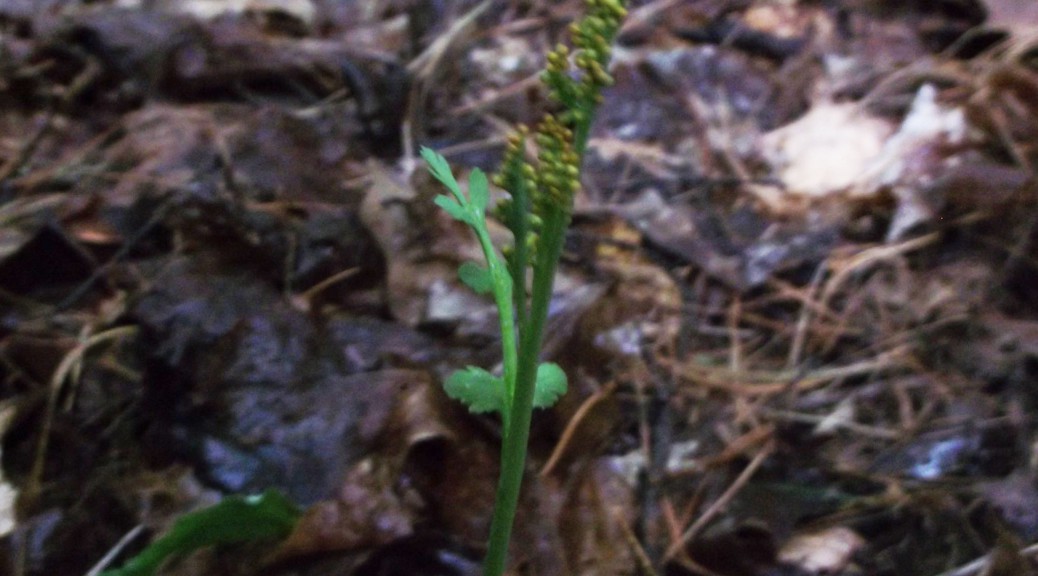
In late spring, when the morel hunters and spring wildflower admirers have disappeared from the woods, I go out in search of grape ferns, the Botrychiums. They are not good to eat, they do not possess colorful leaves, and they lack flowers altogether. Still, they have their strong points: for one thing, reputedly they can make the collector invisible. So far, I have been unable to demonstrate their potency in this regard, but given the antiquity of the claim, I will check it out one more time—the herbalists of old can’t have been totally wrong on this one—or can they?
The Botrychiums (Greek for “grape”) stand no more than a few inches high. Named for the cluster of spore-producing bodies (sporangia), they remind us of bunches of tiny grapes held above a single green leaf. I have always found the most common species, Botrychium matricariodes, among young maple saplings on bare ground swept clear of last year’s leaves. As with morel hunting, you go along without seeing them for a time—and then, suddenly, you see the first and then another and another. They occupy a large area: dozens can be found at one place.
Botrychiums mostly spend their lives underground. First, spores must land at in an appropriate habitat. Upon arriving there, they grow underground, feeding upon nutrients produced by other plants by taking advantage of soil fungi that interconnect with their roots. After several years of growth–providing the above ground vegetation has progressed from weeds to young trees–grape ferns first appear above ground, finally shedding their spores to the wind. Thereafter, they sporadically appear every year—usually in late May and June—with some years better than others. After as long as 50 years, the habitat becomes unsuitable for them as trees age and the leaf litter becomes too thick for them to emerge above ground. They are not found in mature hardwoods.
Besides “grape ferns”, Botrychiums are called “moonworts”, after a species that produced leaflets reminiscent of half moons. This species alone confers invisibility to its bearer. In order for the spell to work, “fern seeds” must be gathered at midnight on June 23rd, St. John’s Eve, the shortest night of the year. Here we must pause: What are “fern seeds”? Hundreds of years ago people thought all green plants produced seed and were puzzled by the apparent absence of seeds in ferns. According to the ancient “doctrine of signatures,” characters demonstrated by plants pointed to their use in medicine. If the seeds were invisible, then invisibility might be transferred to humans by the presence of the plant. (Of course, everything is wrong with this idea: the doctrine of signatures has no validity and ferns reproduce by nearly invisible spores, not seeds.)
In order to catch invisible fern seed a seeker needed to stack twelve pewter plates, placing the fern frond on the top one. The invisible seeds would drop through the stack, finally resting at the bottom-most plate. Of course, there were other necessary behaviors: he must go bare-footed, wear a shirt, and be in a religious state of mind. Even observing all of these conditions, he might suffer failure if wandering fairies steal the fern seed.
It is clear why my efforts to attain invisibility will likely fail: no pewter plates, no desire to walk barefoot through the woods, and the ever-present possibility of thievish fairies. In fact, no fern seed at all. Most likely moonworts will not unshoe horses that step on them, loosen iron nails, or break chains by their touch. Nor will they empower woodpeckers to peck holes through iron if rubbed upon their beaks (a feat rather difficult to accomplish!). No, grape ferns only bring joy to their discoverers in the month of June. They bestow no particular virtues—no invisibility, no uncanny ability to penetrate iron. Still, they please us by their mere presence—much as the returning songbirds do. Look for them in June on bare hillsides wherever young trees grow.

